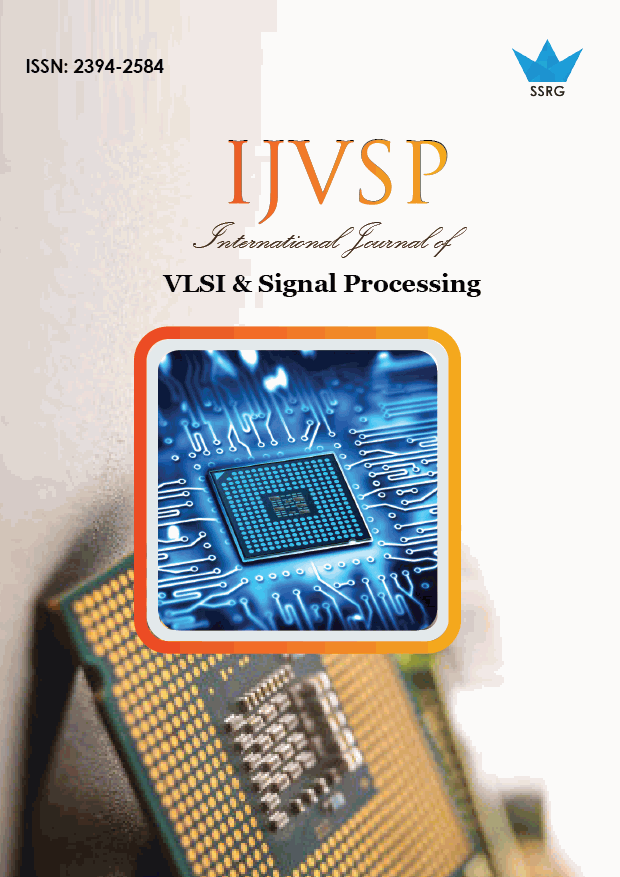Design of a Data Acquisition System and Analysis of Vibration Signals on Helicopters

| International Journal of VLSI & Signal Processing |
| © 2025 by SSRG - IJVSP Journal |
| Volume 12 Issue 2 |
| Year of Publication : 2025 |
| Authors : Sinan Akbaş, Selda Güney |
How to Cite?
Sinan Akbaş, Selda Güney, "Design of a Data Acquisition System and Analysis of Vibration Signals on Helicopters," SSRG International Journal of VLSI & Signal Processing, vol. 12, no. 2, pp. 9-27, 2025. Crossref, https://doi.org/10.14445/23942584/IJVSP-V12I2P102
Abstract:
Health and monitoring of aircraft vibrations are crucial to safety. To maintain safe flying, helicopter vibration levels should be kept at a minimum. Therefore, vibration signal analysis and systems that measure vibration levels are very important topics in the avionics industry.
In the scope of this thesis, the Flight Test Instrument (FTI) system is designed for data acquisition purposes. The FTI system consists of a power module, controller module, analog input module and backplane module. The power module converts input power to desired levels according to system requirements. The controller module is responsible for calculations and communication because it has an FPGA on board. The analog input module is responsible for interfacing with the sensors, signal conditioning, and sampling the vibration signals. The backplane is designed to combine all the modules together.
The study also contains vibration signal analysis. In order to determine the vibration level and phase, different approaches were made. First of all, to determine vibration magnitude, an FFT implementation was made, and for the phase calculation, several digital filters were designed and implemented into the system. Algorithms that are developed have been verified in laboratory environments with a constant vibration generator device; measurements from a helicopter were taken to measure the vibration level. A commercial off-the-shelf (COTS) device was used in helicopter experiments to compare the results, and the results and comparisons have been shared. Afterwards, several machine learning algorithms (such as SVM, GPR, linear regression, etc.) are trained for vibration magnitude and phase prediction. Simulation results have been shared and evaluated for these algorithms.
Keywords:
Signal Processing, Machine Learning, Hardware Design, Flight Test Instrument, Vibration Signals.
References:
[1] Donald R. Houser, and Michael J. Drosjack, Vibration Signal Analysis Techniques, Ohio State University, 1973.
[Google Scholar] [Publisher Link]
[2] Biji Mathew et al., “A Review on Vibration Analysis of Helicopter Rotor Blade,” International Journal for Research in Applied Science and Engineering Technology, vol. 10, no. 2, pp. 1363-1369, 2022.
[CrossRef] [Google Scholar] [Publisher Link]
[3] Curtiss-Wright, Data Acquisition Systems. [Online]. Available: https://www.curtisswrightds.com/products/flight-test/data-acquisition
[4] Traco Power, TEN20WIN Series, 20Watt, 2025. [Online]. Available: https://www.tracopower.com/ten20win-datasheet
[5] Analog Devices, Analog Filter Wizard. [Online]. Available: https://tools.analog.com/en/filterwizard/
[6] Texas Instruments, Quad/Octal, Simultaneous Sampling, 24-Bit Analog-to-Digital Converters. https://www.ti.com/lit/ds/symlink/ads1274.pdf?ts=1737971409427&ref_url=https%253A%252F%252Fwww.google.com%252F
[7] Zhou Wang, and Alan C. Bovik, “Mean Squared Error: Love it or Leave it? A New Look at Signal Fidelity Measures,” IEEE Signal Processing Magazine, vol. 26, no. 1, pp. 98-117, 2009.
[CrossRef] [Google Scholar] [Publisher Link]
[8] Dulakshi Santhusitha, and Kumari Karunasingha, “Root Mean Square Error or Mean Absolute Error? Use Their Ratio as Well,” Information Sciences, vol. 585, pp. 609-629, 2022.
[CrossRef] [Google Scholar] [Publisher Link]
[9] Vikramaditya Jakkula, “Tutorial on Support Vector Machine,” School of EECS, Washington State University, Pullman, vol. 37, 2006.
[Google Scholar] [Publisher Link]
[10] Barry de Ville, “Decision Trees,” Wire Computational Statistics, vol. 5, no. 6, pp. 448-455, 2013.
[CrossRef] [Google Scholar] [Publisher Link]
[11] Eric Schulz, Maarten Speekenbrink, and Andreas Krause, “A Tutorial on Gaussian Process Regression: Modelling, Exploring, and Exploiting Functions,” Journal of Mathematical Psychology, vol. 85, pp. 1-16, 2018.
[CrossRef] [Google Scholar] [Publisher Link]
[12] Martin Sewell, “Ensemble Learning,” UCL Department of Computer Science, 2011.
[Google Scholar] [Publisher Link]

 10.14445/23942584/IJVSP-V12I2P102
10.14445/23942584/IJVSP-V12I2P102